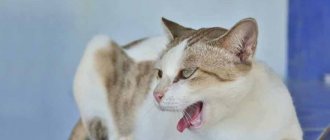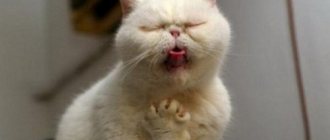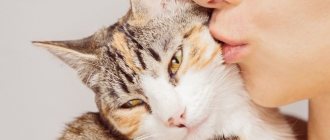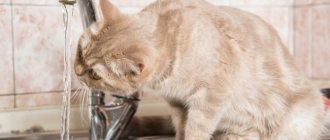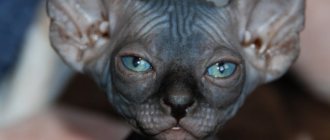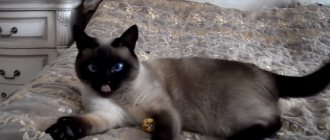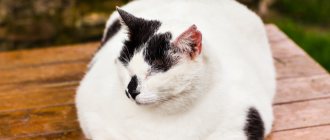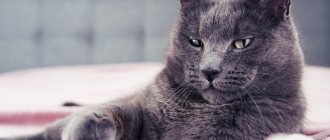Types of cough in cats
Coughing in cats is always a symptom of some disease or condition; it occurs infrequently and looks like an alarming indicator of a cat’s health problems. Smart cats skillfully avoid situations that provoke coughing - they show less physical and emotional activity, try to stay in places with good ventilation, so coughing will not always be the initial sign when a disease occurs.
The cough is reflexive in nature and appears when the respiratory tract receptors are irritated; it helps cleanse the mucous membrane from various irritants of a mechanical, chemical and microbial nature. A cough usually manifests itself quite characteristically: by contracting the diaphragm and respiratory muscles, the cat draws in its stomach and arches its back, its neck is usually stretched down; she makes abrupt coughing and wheezing sounds.
It is necessary to pay attention to the nature of the cough, the circumstances causing it, as well as other symptoms that help identify the disease.
When coughing, the cat takes a typical pose
According to the main parameters, cough can be divided into:
- dry and wet: a wet cough is accompanied by sputum production; with a dry cough there is no phlegm, it is more severe;
- by sound: the sound can be muffled or ringing;
- by duration: a cough that occurs for the first time, the duration of which does not exceed a week, is considered acute. Chronic cough may be present for months;
- in connection with the time of day or year: morning, daytime, evening and night cough;
- spring, summer, winter, autumn;
Cough with a foreign body in the throat
A foreign body in the upper respiratory tract in cats is rare and manifests itself as a sudden attack of severe coughing, suffocation, and cyanosis of the mucous membranes, which is never observed, for example, when a cat tries to regurgitate a hairball from the stomach. The pet should be taken to a veterinary clinic as quickly as possible to remove the foreign body.
Cough from inhaling irritants
Inhaling the odors of household chemicals, perfumes, and cigarette smoke can provoke a coughing attack in a cat, which is usually accompanied by sneezing. Coughing and sneezing occur directly under the influence of an irritating odor.
The first thing you should make sure of when a cat suddenly coughs is that there is no foreign body in the respiratory tract, which is manifested by difficulty breathing, cyanosis of the mucous membranes
Cough due to illness
Cough is a valuable diagnostic sign for a number of diseases.
Respiratory viral infections
Cough appears in infectious diseases that involve the respiratory system. Along with a cough, the following is usually observed:
- fever;
- general oppression;
- lack of appetite;
- depending on the type of pathogen, it may be: conjunctivitis;
- diarrhea;
- elements of a skin rash or lesions of the mucous membranes.
The nature of the cough changes during the course of the disease: from dry it becomes wet.
Asthma
Asthma is a chronic inflammatory disease of the respiratory tract, in which cells of the immune system take an active part. The cause of asthma is an allergy, very often to pollen, household chemicals, but, theoretically, it can be any substance. Asthma is characterized by attacks of spastic contraction of the bronchi, which is manifested by convulsive cough and shortness of breath; the cat breathes with its mouth open. The cough manifests itself in attacks, with no cough in between. There is also no fever or other manifestations characteristic of the development of an infectious disease. Asthma is characterized by seasonality - spring-autumn, as well as a tendency to night coughing attacks, this is due to the weakening of natural sympathetic innervation at night, which prevents the narrowing of the bronchi.
In asthma, the cough has a paroxysmal character, often associated with exposure to an allergen, for example, pollen.
Pneumonia
Pneumonia usually occurs as a complication of an ongoing infectious disease and is characterized by a deterioration in the condition in the form of increased fever, progression of general depression, and severe cough with sputum. Sometimes pneumonia is caused by nonspecific flora, for example, when a cat is severely hypothermic, if it has heart failure or immunodeficiency conditions.
Helminthiasis
With some helminthiasis, cough occurs when worm larvae migrate and are carried into the bronchi and lungs through the bloodstream. Cough due to helminthiasis is short-lived and moderate in nature, and may result in vomiting. In some cases, with massive infection by helminths, they penetrate into the stomach and esophagus, which also causes coughing.
Heart diseases
With heart disease, its size gradually increases; the enlarged heart puts pressure on the trachea, causing coughing. A cough in heart disease sounds muffled and is not accompanied by sputum production; develops gradually and intensifies with physical activity. In parallel, you can find other symptoms of heart disease:
- weight loss;
- pallor or cyanosis of the mucous membranes and unpigmented nose;
- increasing weakness and lethargy of the cat;
- heart rhythm disturbances;
- with the development of ascites, the size of the abdomen increases;
- fainting.
Chest injuries
In case of chest injuries, surgical emergencies may occur, accompanied by coughing:
- pneumothorax - accumulation of air in the pleural cavity as a result of injury to lung tissue by a broken rib;
- hemothorax - accumulation of blood in the pleural cavity due to injury to a blood vessel;
- chylothorax - if, as a result of a chest injury, the thoracic lymphatic duct ruptures, lymph accumulates in the pleural cavity;
- diaphragmatic hernia - in case of severe injuries, the diaphragm ruptures and the abdominal organs exit into the chest; At the same time, shortness of breath and cough develop.
These are severe life-threatening conditions in which shortness of breath, cardiac dysfunction, and shock are observed. The cat's life depends on how quickly it is taken to the veterinarian. The veterinary clinic carries out a complex of anti-shock measures and drainage of the damaged pleural cavity with the removal of air or accumulated fluids, which helps to straighten the lung and restore its function.
Treatment method and prognosis
There is no single treatment regimen for cough. When developing a scheme in each specific case, the specialist will naturally start from the cause that caused the pathology, the age and individual characteristics of the animal’s body.
So, for heartworm, which, by the way, is quite rare in our latitudes, the pet is prescribed bronchodilators. However, if there are too many worms, they can be removed surgically.
For cat flu, symptomatic therapy is prescribed: fluid to prevent dehydration, intravenous administration of buffer compounds. Antibiotics are indicated to treat secondary bacterial infections.
Anti-inflammatory drugs, steroid hormones, and vitamin therapy are used to treat asthma. Bronchodilators are designed to open the airways and make breathing easier.
It is advisable to use medications in the form of inhalations, since tablets are poorly absorbed by the body, and their active components do not enter the bronchi. It is advisable to use nebulizers, which are currently widely used in veterinary practice.
If the cough is of allergic origin, it is necessary to protect the animal from contact with the provoking factor (plants, dust, tobacco smoke, etc.). Medications include cortisone, steroids, and antihistamines.
For pulmonary edema, the use of cardiac and expectorant drugs, intravenous administration of glucose, sodium chloride is indicated. Hypostatic pneumonia is treated with antibiotics.
For cardiac pathologies, the veterinarian selects beta blockers (Atenolol, Propranolol), inhibitors (Benazepril, Enalapril), diuretics (Furosemide).
If air, lymph, or blood have accumulated in the pleural area, a drainage procedure is performed to pump them out. Then the cavity is treated with an antiseptic solution, antibiotic therapy is carried out, analgesics, antipyretics, and diuretics are prescribed.
For fungal diseases, the use of antifungal drugs is necessary. Itraconazole, Amphotericin, and Fluconazole are considered the most effective.
Nasopharyngeal polyps, benign and malignant tumors are removed surgically. If the tumor is inoperable, radiation and chemical therapy are used.
Hairballs stuck in the stomach are eliminated by the cat on its own. This process can be accelerated with the help of special food and malt paste.
In what cases should you urgently consult a doctor?
A doctor should be consulted in all cases of coughing in a cat, especially if the cause is unknown. Cough is a symptom of a large number of diseases, and to cure it it is important to correctly determine the cause of the disease. The appearance of a cough may indicate the onset of an infectious disease, as well as decompensation of the course of a chronic disease; therefore a visit to the veterinarian is necessary. When visiting a veterinarian, it is important to correctly describe the nature of your cat's cough; You should not give antitussive drugs to your animal yourself, as this will make it difficult to make a correct diagnosis.
If a cough appears, a visit to the veterinarian is mandatory - since there are a lot of diseases that accompany coughing
What can affect a cat's breathing rate?
A cat's breathing rate may change if the animal is scared, angry, surprised, happy... However, these changes are not long-lasting and soon the cat's breathing rate is restored to the normal range.
If you notice that your pet is breathing quickly and shallowly, he is most likely scared. Such breathing can be observed in a cat during pregnancy and childbirth, during veterinary procedures.
During sleep and at rest, the cat breathes less often...↑
Drug therapy for cough in cats
For symptomatic treatment of cough itself, the following is used:
- centrally acting antitussives - block the area of the brain responsible for coughing, thereby breaking the arc of the cough reflex. These drugs are rarely prescribed for intense dry cough that debilitates the animal. They are potent, and it is also necessary to take into account that coughing has a protective function, accelerating the evacuation of pathogens, toxins and inflammatory products from the respiratory tract, therefore, the cat needs it to speed up recovery. Not prescribed for wet cough;
- mucolytic (expectorant) agents - dilute sputum, increasing its quantity by increasing the fluid content; The cough becomes productive, which helps to quickly clear the airways. Mucolytics should be handled with caution and strictly adhere to the dosage prescribed by the doctor, and also avoid their combination in the treatment regimen, as this may result in a slowdown in the evacuation of an increased amount of sputum and the development of pneumonia.
Table: overview of medications used to treat cough in cats
| A drug | Compound | Operating principle | Price, rub |
| Bromhexine | Bromhexine | Increases the amount of sputum, facilitates its removal, slightly reduces the intensity of cough | from 20 |
| Codeine phosphate | Codeine phosphate | Refers to narcotic opiates. Blocks the cough center of the brain; can lead to lethargy, constipation, anorexia, vomiting, difficulty breathing and addiction, so it is rarely used. Used to treat intense dry cough. | Not commercially available, only by prescription from a veterinarian; the price is low |
| Potassium Iodide | Potassium iodide | After administration, it is secreted by the bronchial glands and thins mucus. Stimulates the activity of the ciliated epithelium of the respiratory tract, which promotes the removal of sputum | from 57 |
| Mukaltin | Marshmallow herb, polysaccharides | Increases the amount of sputum due to its dilution, facilitating its removal; reflexively stimulates cough activity | from 10 |
Herbal decoctions for treating coughs in cats
The use of herbal decoctions to facilitate the discharge of sputum when coughing is permissible in consultation with a veterinarian, in the absence of other mucolytics in the treatment regimen:
- infusion of plantain leaves: 1 tablespoon of dry plantain leaves is crushed, placed in a thermos and poured with a glass of boiling water. Leave for 6 hours; then cool and filter. Give the cat half a teaspoon 3 times a day;
- infusion of leaves and flowers of coltsfoot: pour 1 tablespoon of crushed flowers and leaves of coltsfoot with a glass of boiling water and heat for 15 minutes in a water bath with frequent stirring; cool and filter. Set 1.7 ml per kg of weight; The daily dose is divided into 2-3 doses per day.
First aid for respiratory arrest
Step-by-step instruction:
How to give artificial respiration to a cat
- Start artificial respiration: lay the cat on its side, pull the tongue forward, cover the mouth with your hand and straighten the neck. Air is inhaled through the cat's nose every 3 seconds. It is important that the chest rises, but does not arch from excess inhaled air.
- During artificial respiration, you need to check for a heartbeat. If the heart is beating but there is no breathing, you need to inhale air at a rate of 10 breaths per minute until the cat breathes on its own.
- If you are completely sure of cardiac arrest, begin chest massage.
- If respiratory arrest is detected and resuscitation begins, it is important that someone call a veterinarian or take the cat and its owner to the clinic.
We invite you to read: How do cats see our world?
Important! Cardiopulmonary resuscitation should not be performed if the cat is conscious.
Instructions on how to perform chest compressions on a cat
Signs of wheezing
The cat is coughing: why it wheezes, the reasons, as if it was choking
Wheezing is understood as noisy breathing, against the background of which a combination of many wheezing and whistling sounds is heard. Such deviation from normal breathing is a frequent companion to most pathologies of the animal’s respiratory tract.
Wheezing can occur for two reasons:
- in the process of narrowing the lumen of the respiratory tract;
- due to the accumulation and foaming of fluid in the respiratory system.
Noises and wheezing when breathing do not bode well
In addition, wheezing means a hoarse, strained voice or its complete absence. This pathology occurs due to incomplete closure of the ligaments due to the accumulation of mucus in the ligament, which is a common symptom of many inflammatory processes.
Helminths
The cat coughs even if there are helminthic diseases. Usually our pets become infected with helminths that parasitize their gastrointestinal tract. But if your pet walks on the street, then barn cats can also become the cause of the disease. If you do not carry out periodic deworming, then after a short time there are so many parasites that, unable to fit in the intestines, they move into the stomach, and from there they enter the external environment with vomit.
In this case, the animal’s immunity weakens. And coughing with this disease causes irritation of the receptors of the esophagus (due to vomiting).
